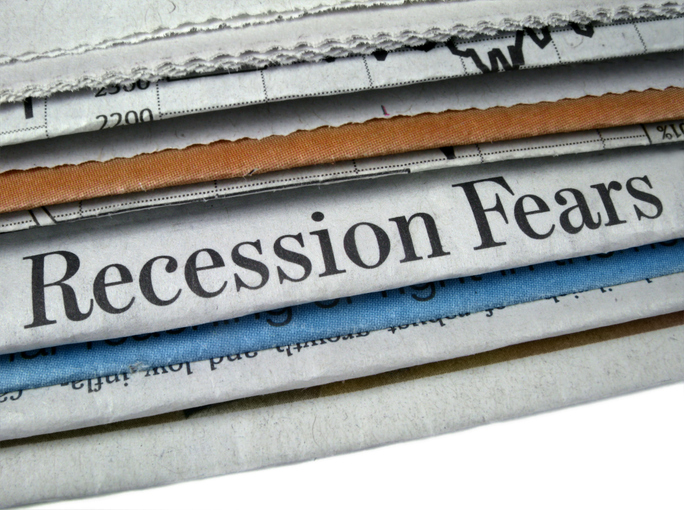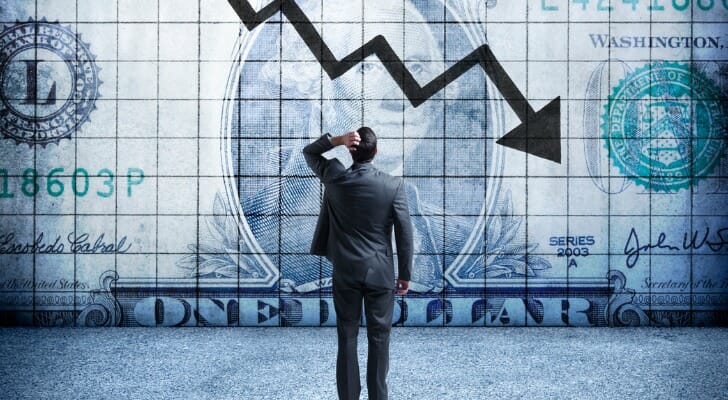Corrections, recessions and depressions can have significant impacts on your investments. A correction is a short-term drop that could create buying opportunities. A recession means the economy is shrinking and may require you to make careful financial decisions. And a depression is a long-term downturn that affects jobs, savings and investments. Here’s what you could expect for all three.
A financial advisor can help you get through the ups and downs of the market by creating a smart investing plan for your needs and goals.
What Is a Correction?
A “correction” describes when an asset or industry loses a significant amount of value. Market corrections occur when that loss is felt over an entire market (such as the New York Stock Exchange or NASDAQ) or index (such as the Dow Jones Industrial Average or the S&P 500).
There is no formal definition for a market correction. However, the common rule of thumb is that a correction has occurred when the value of a key benchmark stock index, such as the S&P 500, falls by 10% or more. While there is also no set rule about the time period for a correction, analysts also generally consider them short-term events.
This is called a correction because prices are “correcting” to more accurately reflect the true value of the underlying assets. In an efficient market this should periodically happen; just as prices will rise through enthusiasm, they will also correct downward through accurate valuation.
As an example, investors saw stocks like GameStop Corp. (GME) and AMC Entertainment Holdings Inc. (AMC) rise sharply at the beginning of January 2021 when individual investors organized by popular Reddit message boards drove up prices.
Traders who had shorted the stock, or betted that the price of those stocks would fall, were forced to buy it to avoid taking considerable losses on their short positions. This created a frenzy to buy more stock, and drive prices even higher. But experts expect a market correction after trades lose momentum or a bear market, which is a more severe form of correction.
Traders generally consider it a bear market when prices fall by 20% or more. Again, this can either occur within a specific asset, an industry or market-wide. As an example, the Dow Jones and S&P 500 dipped into bear market territory in February and March 2020. But both moved successfully into a bull market after August 2020, where the price of assets continued to rise over time.
What Is a Recession?

Recessions occur when economies suffer sustained losses. There is no formal definition for a recession, but analysts generally use two rules of thumb.
The first, classic definition of a recession is when an economy’s inflation-adjusted GDP has declined for two quarters or more. (It’s important to adjust for inflation in this measure, otherwise rising prices could create an artificial impression of prosperity.) Analysts and journalists often use this definition for its clarity.
Economists, however, tend to rely on a second more ambiguous definition. The National Bureau of Economic Research says that a recession “involves a significant decline in economic activity that is spread across the economy and lasts more than a few months.”
The research organization explains that a recession happens when the economy contracts in general, based on a variety of economic indicators, and ends when it returns to growth. Key indicators include:
- Real gross domestic product (GDP): Shows the total value of goods and services produced and adjusts them for inflation.
- Real income: Tracks income levels after adjusting for inflation to show the purchasing power of consumers.
- Employment: Reflects job growth, unemployment rates and labor market strength.
- Industrial production: Measures business activity through manufacturing, mining and utility output.
- Wholesale-retail sales: Tracks sales at wholesale and retail levels to show consumer spending trends.
It’s important to note that recessions are not measured by performance of the stock market. This is because the stock market is only one aspect of the economy. It measures investment of, access to, and performance by capital. In other words, how easily can businesses get investment, and how do those investors fare.
In fact, many economists argue that in recent decades the stock market has become an increasingly weak measure of overall economic performance, as its gains and losses have correlated poorly with overall prosperity among consumers.
What Is a Depression?
Depressions occur when a recession lasts for longer than usual and is particularly severe. There is no formal or even standard definition for a depression, in part because they are rare events. Corrections occur regularly, and even recessions happen fairly often. Most Americans view the depression of the 1930s as the nation’s only one, but many economists say there have been others, including several in the 19th century.
Arguably the most important job of economists and analysts is to prevent another depression.
The Federal Reserve uses this rule of thumb for a recession: “There are repeated periods during which real GDP falls, the most dramatic instance being the early 1930s. Such periods are called recessions if they are mild and depressions if they are more severe.”
While recessions and corrections are formal market events, depressions are closer to a social description. In technical terms, a depression is more accurately a sustained recession. In practice, it describes a downturn that becomes particularly difficult to recover from, or one in which the normal business cycle (in which a correction periodically leads to a recession, which then leads to undervalued assets being bought up, leading to a returned period of growth) seems to stop working.
How Experts Identify Corrections, Recessions and Depresions
As we already explained, experts use key indicators to determine whether the economy is experiencing a correction, recession, or depression. Each has distinct characteristics that signal its presence and severity.
Correction Indicators
- Stock market volatility: A sudden sell-off in major indexes like the S&P 500 or Dow Jones.
- Investor behavior: A shift toward safer assets, such as bonds or utilities.
- External triggers: Events like interest rate hikes, inflation concerns, or geopolitical tensions.
Recession Indicators
- Real GDP contraction: A shrinking economy with reduced business activity.
- Rising unemployment: A steady increase in job losses and a higher unemployment rate.
- Lower consumer spending: Households cutting back on discretionary purchases.
- Declining industrial production: Reduced output from factories and businesses.
- Financial market indicators: Events like the yield curve inversion, rising oil prices, or a decline in corporate earnings.
Depression Indicators
- Long-term unemployment crisis: A sustained jobless rate at extreme levels.
- Deep GDP decline: A more drastic and prolonged drop in economic output.
- Widespread business failures: A sharp increase in bankruptcies across industries.
- Banking system instability: Failing banks, reduced credit availability, and deflationary pressures.
- Prolonged stock market collapse: Market declines that take years to recover, often exceeding 50% losses.
How to Protect Your Portfolio
One way to protect your portfolio from economic downturns is to diversify investments across different asset classes. For example, an investor with a $100,000 portfolio could spread their money across stocks, bonds, cash reserves, and real estate investment trusts (REITs) to manage risk. The adjustments for a correction, recession, or depression depend on the severity of the downturn.
During a market correction, which is a temporary 10% drop in stock prices, staying invested is important. As an example, you could keep 70% in stocks but shift toward defensive sectors like consumer staples, healthcare and utilities. Holding 20% in bonds will provide stability, while keeping 10% in cash will offer you flexibility to buy stocks at lower prices if the market recovers quickly.
During a recession, which lasts months or years, a portfolio should focus more on income-generating and lower-risk assets. An investor might reduce stock exposure to 50% by selling high-risk stocks and increasing dividend-paying stocks. Bonds could be increased to 30% for added stability, while holding 15% in cash or short-term investments helps cover expenses without selling assets at a loss. Investing 5% in REITs focused on residential and healthcare properties can provide additional diversification.
During a depression, which is a severe and long-lasting economic downturn, extreme caution is needed. Stock exposure could be lowered to 30%, focusing only on essential industries and blue-chip dividend stocks. Bonds could make up 40% of the portfolio, prioritizing government and high-quality corporate bonds. Holding 20% in cash protects against prolonged market instability, while keeping 10% in defensive assets like gold, commodities, or essential REITs provides extra security.
Generally, a well-balanced portfolio with a mix of stocks, bonds, cash and real estate investments can help manage risks in different economic conditions. Adjusting asset allocations based on the severity of a downturn increases your potential for financial stability and long-term growth.
Bottom Line

During a correction, prices fall significantly across a single asset, industry or an entire market. A recession occurs when an entire economy contracts for several months. If the recession persists and is particularly severe, it may eventually be considered a depression.
Tips for Investors
- A financial advisor can help you prepare for the ups and downs of the economy. Finding a financial advisor doesn’t have to be hard. SmartAsset’s free tool matches you with vetted financial advisors who serve your area, and you can have a free introductory call with your advisor matches to decide which one you feel is right for you. If you’re ready to find an advisor who can help you achieve your financial goals, get started now.
- With the markets going through an unusually volatile spell, you may benefit from using SmartAsset’s investment calculator. Among other benefits, this tool will give you an idea of how your investments will do based on how much you invest.
Photo credit: ©iStock.com/DNY59, ©iStock.com/Photographer, Filmmaker, Designer, ©iStock.com/NoSystem images
